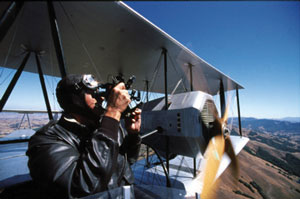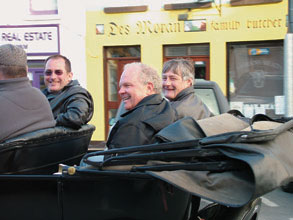...Continued from previous page
The Vimy Replica Takes Off
Reenacting two historic flights—England to Australia and England to South Africa—had required considerable expense and effort. The Vimy team wondered if they had the energy for one last adventure. Ultimately, determination had always led them to the necessary resources. This time, Peter McMillan felt that they needed a minor miracle. Instead, they got a major miracle when Peter learned that renowned aviator and adventurer Steve Fossett was interested in taking the helm of the Vimy across the Atlantic.
Navigator for the 2005 transatlantic crossing was Mark Rebholz, the primary pilot on the flight to South Africa. Although he could navigate with the plane’s modern instruments, he wanted to rely on traditional methods exactly as Arthur Whitten Brown did in 1920. To minimize the use of the instruments, the plane would need to be above the clouds during periods of darkness so that the wings could be kept level by the light of the moon. But would the weather cooperate?
 |
|
| Mark Rebholz practiced using a sextant before the transatlantic flight. Courtesy of Peter McBride. |
|
| |
|
Steve and Mark spent weeks in Newfoundland waiting for repairs to the Vimy replica and then for good weather. Ultimately, after many delays, they had to make the best of imperfect conditions. The forecast showed clouds over the entire route, but clear conditions above 5,000 feet at night. They lifted off an hour and a half before sunset on July 2 in a howling wind.
After crossing the Grand Banks, the Vimy flew between cloud layers, and Steve and Mark lost sight of the waves only 1,500 feet below. Distracting the duo from the poor visibility was the smell of fuel. Mark discovered that fuel was venting from a tank behind the cockpit. More worrisome was the large pool of fuel on the floor under his feet and therefore the possibility of fire. The source of the leak was a tank in the forward cockpit. The Vimy replica did not have a fuel dump system, so Mark adjusted the two valves for the tanks inside the cockpit. Within 10 minutes, the fuel stopped dripping.
As the sun set, the Vimy alternately entered and emerged from the clouds, struggling to gain altitude. Steve worked hard to manipulate the heavy flight controls, while Mark tried to get ready to take a reading with his sextant. In daylight, the few preparations were fast and simple, but they seemed to take forever in the poor light and constant wind. Mark was forced to pull out a small GPS receiver. Although he felt dismayed to rely on this convenience, he was able to determine the Vimy’s position and measure the plane’s progress on his navigation chart.
Steve and Mark flew for what seemed like an eternity in darkness, in near freezing temperatures, and sometimes through light rain. Then, shortly after sunrise, the surface of the sea appeared through the thick clouds. They deviated left or right of their course to avoid the heaviest rain, and now and then they saw a shaft of brilliant sunlight beam down through a break in the clouds.
 |
|
| During a victory parade, Steve Fossett, Mark Rebholz, and John LaNoue, who oversaw the building of the Vimy replica, rode in a 1919 Rolls-Royce. |
|
| |
|
At 17 hours and 34 minutes after takeoff, Steve and Mark sighted the surf breaking on the shore of an island. Minutes later, they saw more surf on the point of the mainland called Cleggan Head. They steered toward the point and crossed the coast. The Vimy was now over Ireland. After circling the village of Clifden, they headed south to the Alcock and Brown memorial and looked down on the original landing site. At 18 hours and 19 minutes after departing Newfoundland, the Vimy touched down on the Connemara Golf Links.
“Seeing the Vimy in the morning sunbeams of Ireland on July 3, 2005,” author Peter McMillan writes in The Vimy Expeditions, “marked the summit of a long climb.”
|
|
|
 |